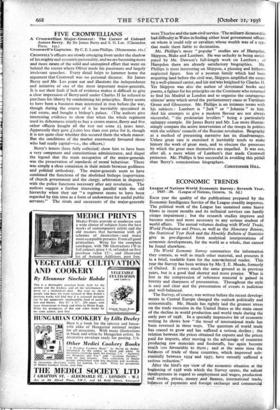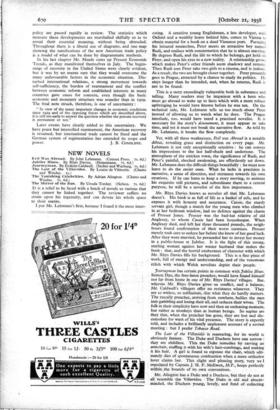League of Nations World Economic Survey : Seventh Year, .
1937-38. (League of Nations, Geneva, 7s. 64.)
ECONOMIC TRENDS
EACH year the quality of the publications -prepared by the Economic Intelligence Service of the League steadily improVes. The political work of the League has sustained some heavy blows in recent months and its technical services can hardly escape impairment ; but the research studies improve and become more and more necessary to any serious student of world affairs. The annual volumes dealing with World Trade, World Production and Prices, as well as the Monetary Review, the Statistical Year Book and the Monthly Bulletin of Statistics give in pre-digested form analytical interpretations of economic developments, for the world as a whole, that cannot be found elsewhere.
The World Economic Survey summarises the information they contain, as well as much other material, and presents it in a brief, readable form for the non-technical reader. This year the Survey has been written by Mr/J. E. Meade, formerly of Oxford. It covers much the same ground as in previous years, but is a good deal shorter and more precise. What is lost in the compression of reference material is gained in brevity and sharpness of presentation. Throughout the style is easy and clear and the presentation of events is judicious and well-balanced.
The Survey, of course, was written before the recent develop- ments in Central Europe changed the outlook politically and economically. Mr. Meade has rightly laid the greatest stress on the trade recession in the United States as the main cause of the decline in world production and world trade during the early part of 1938. In a specially impressive bit of economic writing he shows how " the trend of international trade has been reversed in three ways. The quantum of world trade has. ceased to grow and has suffered a serious, decline ; the relation between the prices obtained for exports and the prices paid for imports, after moving to the advantage of countries producing raw materials and foodstuffs, has again beconie much ins favourable to them ; and at the same time the balances of trade of these countries, which improved sub- stantially between 1934- and 1937, have recently suffered a serious reduction."
After the bird's eye view of the economic situation at the beginning of 1938 with which the Survey opens, the salient developments in regard to employment and wages, production and stocks, prices, money And finance, international trade, balances of payments and foreign -exchange and commercial
policy are passed rapidly in review. The statistics which measure these developments are marshalled skilfully so as to reveal their essential meaning, without being obtruded. Throughout there is a liberal use of diagrams, and one map showing the ramifications of the new American trade policy is a model of what can be done by diagrammatic methods.
In his last chapter Mr. Meade sums up Present Economic Trends, as they manifested themselves in July. The begin- nings of recovery in the United States were clearly evident, but it was by no means sure that they would overcome the many unfavourable factors in the economic situation. Dis- turbed international relations, a strong movement towards self-sufficiency, the burden of rearmament and the conflict between economic reform and established interests in many countries gave cause for concern, even though the basic economic and monetary structure was sounder than in 1929.
The final note struck, therefore, is one of uncertainty : " In view of the many important changes in economic conditions since 1929 and of the opposing forces which are described above, it is still too early to answer the question whether the present recovery is permanent or not."
Later events have clearly added to this uncertainty. We have peace but intensified rearmament, the American recovery is resumed, but international trade cannot be freed and the German system of regimentation has extended its scope and
















































 Previous page
Previous page